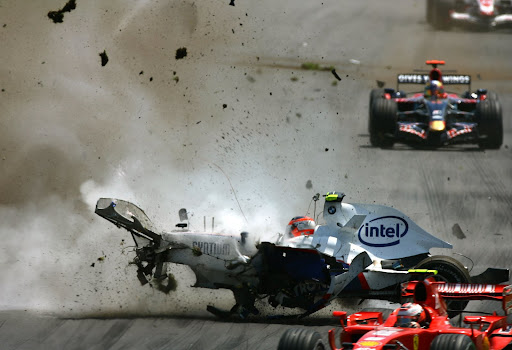Everyone might think Speed thrills but kills. Actually, its the instant stopping that's lethal. Well, not if u have HANS around!
"There are only three sports: Bull fighting, Motor racing and Mountaineering; all the rest are merely games" are the words of Ernest Hemmingway, an American novelist and three-time Nobel laureate of Literature. Well, he includes Motorsports in his classification mainly because the fact that drivers put their lives on the line when they wear the helmets and sit in the cockpit. And, its not just mere words. If someone could recall what happened during Imola Grand Prix in 1994 that saw two of the world's greatest F1 drivers by the names, Ayrton Senna and Roland Ratzenberger, vanish from this world. Not only in Formula 1, such incidents have taken place in Champ Car, Indy Car racing as well as Nascar racing leading to the deaths of a handful of much acclaimed drivers died all of a sudden.
 |
| Ayrton Senna |
 |
| Roland Ratzenberger |
What was the reason for their death? It's simple, it is what they call as Basilar skull fracture caused due to the rapid movement of the neck portion when the car hits an obstacle at very high speeds or G-Force. To say in a word, its like a whiplash.
So, to avoid such accidents, a scientist by the name, Dr. Robert Hubbard from University of Michigan Highway Safety Research Institute, in 1981, started the development of what is HANS(Head and Neck Safety) today, in association with his brother-in-law, Jim Downing who was a friend of a driver, Patrick Jacquemart, who died while racing in the Ohio race track. Yes, it was in 1981 that a major development was researched for the driver's safety.
The development of HANS was essential because the portion where the basilar skull fracture would occur, is not covered by the helmet. To describe HANS, It is a U-shaped device that rests behind our necks and the U-shaped component extends up to the top of our chest. Its function is to reduce the free-flow movement of our neck when subjected to high G-Force(or opposing force). What it does is, it reduces the relative motion of the neck part with respect to the body.
Initially, the governing bodies of all motor sports opposed this idea but Hubbard and Downing were too determined to let it slip. It was February 18, 2001, at Daytona 500, the last lap of the Nascar race when Dale Earnhardt was tangled between his colleagues, lost his control and died due to basilar skull fracture again. Nascar had lost one of its icons. In what was known to be the then deepest Nascar crash investigation in 50 years, the results were that Dale's neck moved very fast towards the steering of the car when it collided with the fence. He was dead instantaneously as soon as he hit the steering.
It was then that all motorsport governing organizations supported the development of HANS. After much debate, study and advancements, the Nascar as well as Indy car racing governing bodies made HANS mandatory in 2001. FIA(Formula 1 governing body) made it mandatory in 2003.
 |
| Robert Kubica's Crash in Montreal 2007 |
Since then, HANS has done good to save many drivers' lives during races. One of HANS' notable contribution was the accident of Robert Kubica in Montreal 2007. Robert was subject to multiple impacts and he survived all without the basilar skull fracture with mild head trauma and hair-line fractures to his neck. He was back on track within almost 6 months of his life threatening crash.
So, Mere 'drive to the finish ahead of everyone' is not racing; danger and safety are integral parts of motorsports and as long as HANS exist, it takes care of those life ending incidents, ultimately, saving countless lives in the process.










0 comments:
Post a Comment